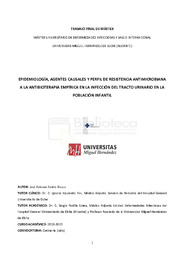Por favor, use este identificador para citar o enlazar este ítem:
https://hdl.handle.net/11000/27425Epidemiología, agentes causales y perfil de resistencia antimicrobiana a la antibioterapia empírica en la infección del tracto urinario en la población infantil
| Título : Epidemiología, agentes causales y perfil de resistencia antimicrobiana a la antibioterapia empírica en la infección del tracto urinario en la población infantil |
| Autor : Antón Blasco, José Antonio |
| Tutor: Izquierdo Fos, Ignacio Padilla Urrea, Sergio |
| Editor : Universidad Miguel Hernández |
| Departamento: Departamentos de la UMH::Medicina Clínica |
| Fecha de publicación: 2019-07-11 |
| URI : http://hdl.handle.net/11000/27425 |
| Resumen : INTRODUCCIÓN: La susceptibilidad de los patógenos causantes de ITU en la población pediátrica a la antibioterapia empírica utilizada ha ido disminuyendo de forma progresiva y por ello, resultará clave conocer las tasas de resistencia locales de los uropatógenos más frecuentes. Con ello, se podrá establecer un régimen de antibioterapia empírica adecuado a las características de la población local. OBJETIVO: Determinar la tasa de resistencia a los principales antibióticos (gentamicina y cefotaxima) utilizados como tratamiento empírico de la ITU con criterios de ingreso. Además, como objetivos secundarios se pretende conocer los factores de riesgo asociados a dicha resistencia para establecer modificaciones en el protocolo terapéutico, describir las características epidemiológicas de los pacientes afectos y describir los gérmenes involucrados en la etiopatogenia de las ITU de nuestra población. MATERIAL Y MÉTODOS: Estudio observacional descriptivo de tipo transversal de una cohorte de pacientes en edad pediátrica ingresados en el Servicio de Pediatría por ITU entre Enero de 2015 y Octubre de 2018. Se llevó a cabo una revisión de la Historia Clínica de los 151 pacientes incluidos y, mediante la misma, se recogieron las variables a estudio que posteriormente se analizaron con el fin de cumplir los objetivos descritos. RESULTADOS: Las ITU conforman el 10% de los ingresos en el Servicio de Pediatría y, en el 64’2% de los casos están causadas por Escherichia coli, destacando además la existencia de un elevado porcentaje de BLEE (4’6%). La gentamicina fue la antibioterapia empleada en el 56,5% de los casos, objetivando que el 15’15% de los gérmenes aislados en el urocultivo eran resistentes a la misma. Los principales factores de riesgo asociados fueron el diagnóstico de malformación renal (RR 2’98, IC95% [1’10-8’05]), el ingreso en los seis meses previos (RR 11’48, IC95% [3’16-41’68]), la existencia de ITU previa (RR 3’45, IC95% [1’30-9’64]) y el estar tomando profilaxis antibiótica (RR 4’66, IC95% [1’62-13’4]). La cefotaxima presenta menos tasas de resistencia como antibioterapia empírica en la población general (7’69%), aunque se asocia a los mismos factores de riesgo que la gentamicina. CONCLUSIONES: En base a los perfiles de resistencia antimicrobiana locales, la gentamicina parece un tratamiento inapropiado como tratamiento empírico inicial en nuestra población. La cefotaxima podría ser una buena opción en la población sin factores de riesgo, mientras que en caso de malformación renal y/o antecedentes patológicos de interés sería conveniente administrar una antibioterapia con la que dichos factores no presenten asociación significativa. En caso de sospecha y factores de riesgo de BLEE, según los perfiles de resistencia locales, la piperazilina-tazobactam y los carbapenems podrían ser una adecuada antibioterapia empírica. INTRODUCTION: The susceptibility of UTI-causing pathogens in the paediatric population to the empirical antibiotic therapy has been progressively decreasing and, therefore, it is key to know the local resistance rates of the most frequent uropathogens. This will enable the establishment of an empirical antibiotic therapy regimen appropriate to the characteristics of the local population. OBJECTIVE: To determine the rate of resistance to the main antibiotics (gentamicin and cefotaxime) used as empirical treatment of UTI with criteria. In addition, the secondary objectives are to know the risk factors associated with this resistance in order to establish modifications in the therapeutic protocol, to describe the epidemiological characteristics of the affected patients and to describe the germs involved in the etiopathogenesis of the UTI in our population. MATERIALS AND METHODS: Descriptive observational cross-sectional study of a cohort of paediatric age patients admitted to the Paediatric Service by UTI between January 2015 and October 2018. A review of the Clinical History of the 151 patients included was carried out and the variables to be studied were collected and subsequently analysed in order to meet the objectives described. RESULTS: The UTIs make up 10% of the admissions to the Paediatric Service and in 64.2% of the cases they are caused by Escherichia coli, highlighting the existence of a high percentage of ESBL (4.6%). Gentamicin was the antibiotherapy used in 56.5% of the cases, objectifying that 15.15% of the germs isolated in the urine culture were resistant to it. The main associated risk factors were: the diagnosis of renal malformation (RR 2'98, 95%CI [1'10-8'05]), admission in the previous six months (RR 11'48, 95%CI [3'16-41'68]), the existence of previous UTI (RR 3'45, 95%CI [1'30-9'64]) and taking antibiotic prophylaxis (RR 4'66, 95%CI [1'62-13'4]). Cefotaxime has lower rates of resistance as empirical antibiotic therapy in the general population (7'69%), although it is associated with the same risk factors as gentamicin. CONCLUSIONS: Based on local antimicrobial resistance profiles, gentamicin appears to be an inappropriate choice as an initial empirical treatment in our population. Cefotaxime could be a good option in the population without risk factors, while in case of renal malformation and/or pathological history it would be convenient to administer an antibiotherapy with which these factors do not present a significant association. In case of suspicion and risk factors of ESBL, according to local resistance profiles, piperaziline-tazobactam and carbapenems seem to be an adequate empirical antibiotherapy. |
| Palabras clave/Materias: infección orina pediatría gentamicina urinary tract infection pediatry gentamicin |
| Área de conocimiento : CDU: Ciencias aplicadas: Medicina |
| Tipo de documento : info:eu-repo/semantics/masterThesis |
| Derechos de acceso: info:eu-repo/semantics/openAccess |
| Aparece en las colecciones: TFM-M.U Enfermedades Infecciosas y Salud Internacional |
 La licencia se describe como: Atribución-NonComercial-NoDerivada 4.0 Internacional.
La licencia se describe como: Atribución-NonComercial-NoDerivada 4.0 Internacional.
.png)
